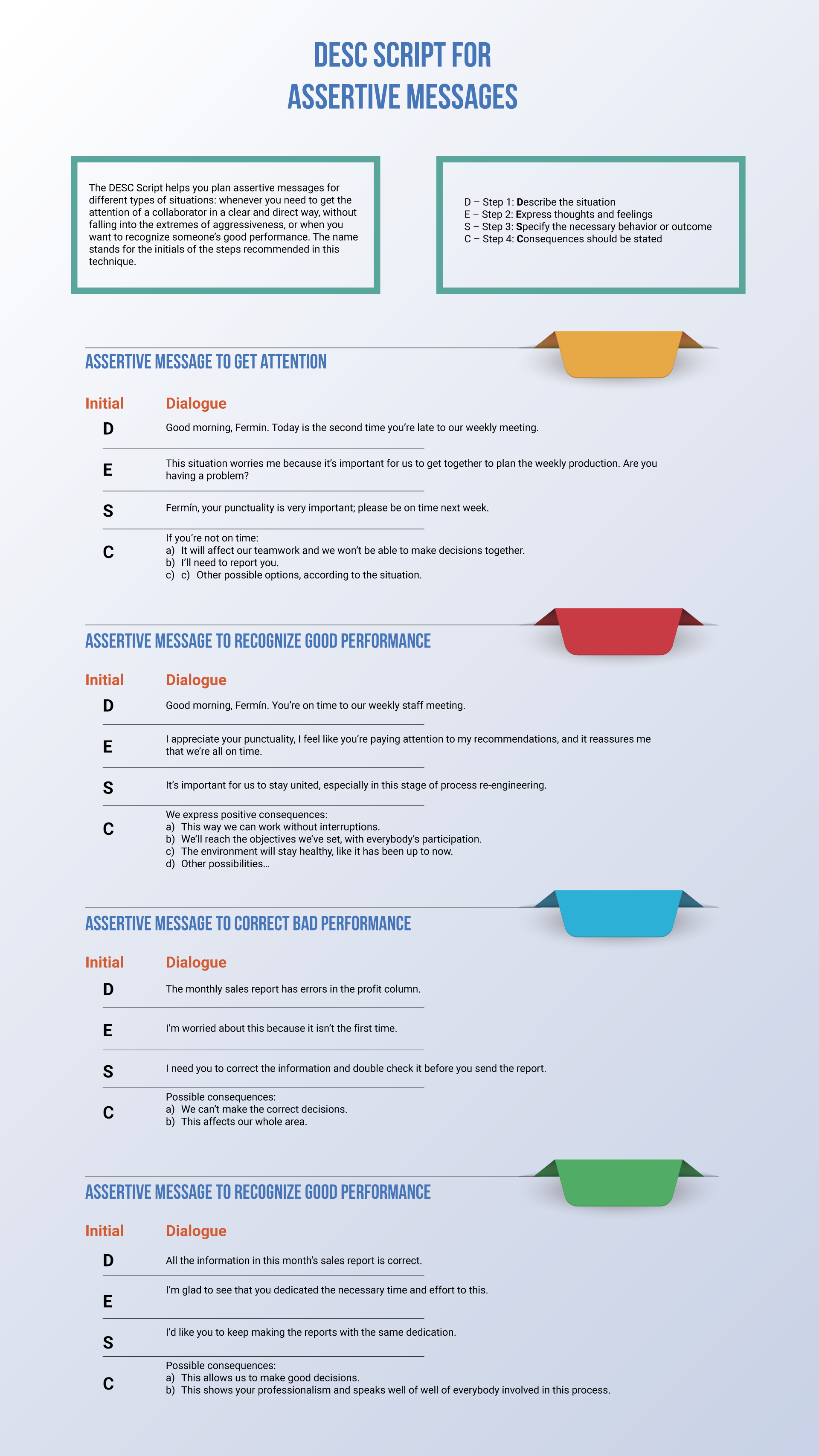Week 2 - Assertive Communication - direct, clear, respectful, firm
Overview on assertive communication
- “assertive” means to compel, to go directly
- communicate with messages that are delivered clearly, firmly, directly, and respectfully
- the success of assertive communication largely depends on how the recipient perceives the message. It’s crucial to analyze the situation and the recipient before conveying the message, understanding that there are degrees to assertiveness.
- strategize how the message is conveyed, considering not just the content but also emotions, desired outcomes, and potential consequences
- Open aggression can elicit responses of aggression or evasion, while passive aggression, characterized by sarcasm and ambiguity, can confuse recipients.
- it is important to consider who we are directing our message to, before sending it
- evaluate their way of being, their previous responses to our communication and, in general, all the sociocultural conditioning of the person
Empathy - being sensitive to the feelings of the other person
The communicative leader is able to direct, teach, guide, motivate, and solve problems continuously. Assertive leaders feel free to express themselves just as they are. Their words and actions confirm: this is who I am and this is how I feel, think, and what I want
Communication channels 50% body language, 40% hearing, 10 % analysis

Benefits of assertive communication
- promotes quality and respect
- promotes collaboration
Questions for my communication strategy
- What does the other person need?
- What does he or she need from me?
- How do I feel about this situation? How do I feel about this?
- How could the other person think and feel about this?
- What communication channel is most appropriate: e-mail, phone call, personal dialogue, voice message, or electronic message?
DESC - Describe - Express - Specify - Consequences
Key components of assertive messaging include Describing, Expressing, Suggesting alternatives, Consequences.
D - stands for Describing the situation clearly
Description: Clearly focus on the specific event. For example, rather than saying “this report is poorly done,” specify exactly what the issue is, such as an error in a sales column in a report. This precision helps avoid generalities and potential misunderstandings.
E - is for Expressing feelings about the situation
Expression of Emotions: Express how you feel or think about the situation, which can release stress and provide weight to the message. Phrases like “I’m worried about this situation” can be effective. It is emotionally freeing to express our feelings, avoiding the extremes of repression or toxic, negative manifestations of emotions.
S - is for Suggesting alternatives or solutions
Request for Action: After detailing the problem and expressing feelings, suggest solutions or ask the person for their input.
C - refers to detailing the Consequences of the issue
Consequences: Discuss the potential impact of the situation on individuals, teams, or the company.
Several assertive message examples
The first step in delivering an assertive message is to identify the situation or the condition that we want to refer to, and express it as clearly and precisely as possible.

Self Diagnosis for own Communication Style
Questions
- I see adequate blocks of time to engage in peaceful dialogue to solve conflicts in a productive way
- I usually communicate clearly, directly and respectfully with my bosses and/or directors
- I usually communicate clearly, directly and respectfully with my co-workers
- I usually listen carefully and respectfully to understand my managers and/or directors
- I usually listen carefully and respectfully to understand my managers co-workers
- At work meetings, I try to listen carefully, with understanding and respect for all involved
- I set aside periods of time to establish my goals and evaluate my performance
- I dedicate sufficient time to establish goals and evaluate my collaborators performances
- If I need to bring a matter to a colleague’s attention, I do so in a clear, direct, respectful waz
- I give positive recognition to my colleagues well done activities to motivate them to keep improving
Interpretation
Fewer than 5 answers checked “yes, indicate your communication is deficient, which can generate conflicts among people, as well as frustration and lack of motivation
6 to 8 answers checked “yes” indicate you have good communication, but it could improveRemember that the work environment is characterized by peace and the assurance of achieving results.
More than 8 answers checked “yes” indicate your communication as excellent. Thanks to this, your coworkers and collaborators feel motivated and willing to kong improving because the organization objectives are clear and feedback is given so they can ing their performance.
Questions for reflection on the self assessment
- What positive behaviors could you identity in the way you communicate?
- What behaviors of yours do you feel need improving?
- How do you think your way of communicating affects people and results?
- What factors do you think influence the way you communicate with others?
- What conclusions can you make based on these observations that will allow you to improve your communication as a leader, both in the work environment and in your personal environment?